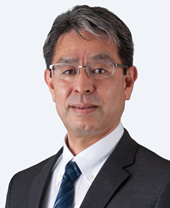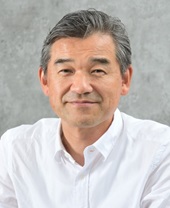
The second part of Yasumasa Matsui Explores the Frontlines of Nuclear Energy features an interview with Kohei Hisamochi, who became President of Hitachi GE Vernova Nuclear Energy in April 2025. Nuclear power generation systems are again attracting attention as one of the stable energy systems that support a carbon-neutral and digital society. The nuclear energy business is entering a new stage because domestic power plants are restarting, small modular reactors are being commercialized, among other factors. Now Hitachi’s Nuclear Energy business is required to increase the safety of nuclear power generation, gain the trust of society, and drive growth. What is on President Hisamochi's mind?
The first half of the interview focuses on the reasons why President Hisamochi studied nuclear engineering at university, his personal history, the accident at the Fukushima Daiichi Nuclear Power Station and the collaborative creation with GE Vernova.


Matsui: Nice to meet you. Thank you for your time today. Let me introduce myself briefly. I joined TV Asahi Corporation in 1986 and worked as an announcer for 25 years. After Japan was hit by the Great East Japan Earthquake and the accident at the Fukushima Daiichi Nuclear Power Station in 2011, I became a dedicated nuclear accident journalist. Now, I work as a freelance announcer and journalist. You were appointed to be president of Hitachi GE Vernova Nuclear Energy in April 2025, President Hisamochi. Did you pursue a career as an engineer in the nuclear energy field before then?
Hisamochi: Yes. Since I joined Hitachi in 1993, I have mainly been engaged in safety measures. For example, I handled severe accident countermeasures for Boiling Water Reactors (BWR) and conducted Probabilistic Safety Assessments (PSA). PSA is a method of assessing safety by calculating risks through quantifying the probability of various potential events at nuclear facilities and their impact.
Matsui: I have heard that you graduated from Kyushu University 's graduate school. Were you born in Kyushu?
Hisamochi: Yes. I was born in Matsuura, Nagasaki and lived there until I finished high school. I then studied nuclear engineering at Kyushu University and its graduate school.
Matsui: Why did you choose to study nuclear engineering at college?
Hisamochi: Growing up in Nagasaki, I often heard stories about the atomic bombing, which naturally led me to think deeply about war and nuclear energy. I concluded that what led Japan to war was that Japan lacked domestic resources, and I wanted to work to solve energy resource issues in the future. Hearing about the scientists who developed the atomic bomb made me strongly determined to become an engineer who could apply nuclear energy for peaceful ends.
Matsui: There are many different specialties in nuclear engineering. Did you start researching nuclear reactor safety assessment as a student?
Hisamochi: No. When I was a student, I aimed to be a researcher. I was interested in theoretical fields like quantum mechanics and particle physics. For example, I conducted experiments using accelerators to collide protons with metals and analyzed nuclear spallation reactions. This type of research can usually be applied in the medical field. When I was looking for a job, however, I wanted to contribute to efforts to support society as a whole, so I sought a job at an energy-related company.
Matsui: That's why you joined Hitachi. But why Hitachi?
Hisamochi: Because I wanted to be involved in manufacturing in the energy industry—in the construction of large nuclear facilities. There were not so many companies involved in that kind of business, and I chose Hitachi partly because people senior to me recommended the company. I used to discuss the ideal direction of nuclear technologies with them. I had the strong impression that this was a company seriously engaged in nuclear energy, and that also encouraged me to choose Hitachi.

Photos of President Hisamochi, who was born and brought up in Matsuura, Nagasaki (provided by President Hisamochi)
Matsui: After joining Hitachi, you got involved in safety assessment, so you must have been working on the front lines of the industry when the accident at the Fukushima Daiichi Nuclear Power Station occurred.
Hisamochi: Although I was not at the site, I assessed the status of the plant, working with the Government-TEPCO Unified Response Headquarters that took charge of accident response at the head office of the Tokyo Electric Power Company (TEPCO). On the day of the accident, March 11, I was at the Japan Nuclear Safety Institute near Tamachi Station. We were having a meeting in the afternoon when the earthquake occurred. I had an overseas business trip scheduled after that, so I went to Keisei Ueno Station on foot and waited there. It was difficult to get through to anyone over the phone. When I managed to get through to the office in the evening, I was told to give TEPCO help because they were in serious trouble. I still remember it was very hard to go anywhere. In the company building itself, for instance, the elevators were out of service and we had to walk everywhere, up and down t he stairs to the emergency response unit on the 29th floor.
Matsui: On the day, we, the press, gathered at TEPCO's head office. I experienced the seriousness of the situation gradually becoming clear in real time. You must have felt a considerable sense of crisis as you came into contact with information on the front lines of the response to the accident.
Hisamochi: As I mentioned earlier, I was working on severe accident countermeasures at the time. A severe accident is a situation where the core of reactor is significantly damaged. This was exactly what was happening at that time. In fact, I had helped develop the procedures for responding to a core meltdown together with TEPCO, so I had all the necessary steps in mind and was able to explain what needed to be done.
However, it was frustrating that we could not get all the information from the site. I was anxious—wondering if the data we couldn’t see might point to a more serious situation. At the same time, I held on to hope, thinking, “We’ll do everything we can with the data we do have,” and “There are still options.” Deep down, I was prepared for this to be my final role in the nuclear energy field, but I never gave up hope and tackled the situation with a determination to contribute all the knowledge I had as an engineer.
Matsui: We also felt strongly that we had to report the facts and avoid any misinformation. However, in some cases, even if data was disclosed properly, it was learned the data was wrong due to malfunctioning equipment. You were also in a difficult situation. You must have been young at that time.
Hisamochi: I was in my early 40s.
Matsui: To have calmly handled such a major accident at that age shows great strength of character. Knowing that someone like you is now leading Hitachi’s nuclear energy business is reassuring—even though we must do everything to prevent another accident. Were you involved in the response efforts for some time afterward?
Hisamochi: Yes, I provided technical support for reactor core cooling for about six months. At the same time, I discussed safety measures with TEPCO in a way that could be applied in the current nuclear power plants that incorporated lessons from the accident. As someone responsible for plant safety, I was committed to doing everything I could.

Matsui: At that time, Hitachi and the General Electric Company (GE) (currently, GE Vernova) had already formed a joint venture. Did you get any support for your accident response activities?
Hisamochi: We kept in touch with people related to safety measure technologies of our sister company in the US, GE Hitachi Nuclear Energy (currently, GE Vernova Hitachi Nuclear Energy). In the U.S., they had experience with a meltdown at the Three Mile Island nuclear power plant. It was not designed by GE, but the engineers shared their experience and the lessons they learned. They gave advice about controlling reactors during the severe accident at Fukushima.
Matsui: Hitachi GE Nuclear Energy, Ltd. (currently, Hitachi GE Vernova Nuclear Energy, Ltd.) was founded in 2007. It has been almost 20 years since then. I think the relationship of collaborative creation has steadily deepened.
Hisamochi: Yes, I think so, too. Our company was originally founded by Hitachi and GE to globally deliver the latest BWR technologies. In 2024, GE spun off its energy-related businesses, including nuclear, into GE Vernova. As a result, we changed our name to Hitachi GE Vernova Nuclear Energy, Ltd. on June 1 this year. Our U.S. sister company is now GE Vernova Hitachi Nuclear Energy.
GE Vernova, having developed BWRs, has improved their basic design. Hitachi, on the other hand, has continually manufactured and constructed the major equipment for nuclear reactors over the approximately 70 years since it began its nuclear energy business in the 1950s. We are working to advance nuclear technologies and enhance their value by combining the technologies, experience and areas of specialization of the two companies.
Specific examples of collaborative creation include the development of large reactors such as the simply designed Economic Simplified Boiling Water Reactor (ESBWR) which makes natural-circulation cooling possible, the innovative light-water reactor, Highly Innovative Advanced BWR (HI-ABWR), an evolution of the international standard ABWR which is undergoing design certification in the U.K., the BWR-300 small light-water reactor that is a balance of economic efficiency and safety, the development of small reactors such as the power reactor innovative small module (PRISM), a metal-fueled sodium-cooled fast reactor and the maintenance of existing nuclear reactors. The permitting and licensing procedures for the construction of a nuclear power plant are time-consuming and laborious. GE Vernova Hitachi Nuclear Energy is familiar with regulations overseas, including in North America. Our strengths include our manufacturing (monozukuri) and demonstration capabilities. The two companies working together can advance their global expansion.
(Click here to read the second half)

Kohei Hisamochi
President of Hitachi GE Vernova Nuclear Energy
Born in Nagasaki. Received a master's degree in Nuclear Engineering, Department of Applied Atomic Nuclear Engineering, Faculty of Engineering, Kyushu University in 1993. Joined Hitachi, Ltd. the same year. Became General Manager, Procurement and Sourcing Division Nuclear Engineering, Nuclear Business Planning Department, Hitachi-GE Nuclear Energy, Ltd. (currently, Hitachi GE Vernova Nuclear Energy, Ltd.) in 2017, General Manager, Nuclear Engineering and Product Division in 2019, Director (Executive Vice President) and Chief Lumada Business Officer, Nuclear Energy Business Unit, Hitachi, Ltd. in 2020 and President and Representative Director, Hitachi Plant Construction, Ltd. in 2023. Current position from April 2025.

Yasumasa Matsui
Freelance Announcer and Journalist
Born in Inami, Nanto City, Toyama Prefecture. Graduated from Toyama Prefectural Takaoka High School. Graduated from the Department of Chemical Engineering, School of Engineering, Tokyo Institute of Technology (now Institute of Science Tokyo). In 1986, he joined TV Asahi as an announcer. He co-hosted Music Station with Tamori, served as a sportscaster on News Station, and worked as a news and information anchor on programs such as Station Eye, Wide Scramble, and Yajiuma Plus.
In 2008, he became the principal of TV Asahi's announcer school, Ask. During his two years in this role, he trained over 100 announcers who went on to work nationwide. In March 2011, following the 2011 Great East Japan Earthquake (and subsequent Fukushima Daiichi Nuclear Power Station accident), he transferred from the announcer department to the news department as a reporter covering the nuclear power plant accident. He later served as a reporter covering the Imperial Household Agency and weather-related disasters, and worked as a commentator. In 2023, after leaving TV Asahi, he established his own agency, OFFICE Yuzuki. He also serves as a plastic model history research advisor for Tamiya Inc., ambassador for Nanto City, Toyama Prefecture, and media advisor for sake company, DASSAI Inc.